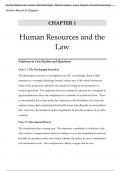(Human Resources Law 5e John Remington, Richard Heiser, Cyrus Smythe, Kenneth Sovereign)
(Solution Manual all Chapters)
CHAPTER 1
Human Resources and the
Law
Solutions to Case Studies and Questions
Case 1.1 The Discharged Executive
The discharged executive is an employee-at-will. Accordingly, there is little
exposure to a wrongful discharge lawsuit, unless any of the verbal assurances
made to the prospective plaintiff were made in writing or incorporated in a
written agreement. The employer does have potential exposure to a complaint of
age discrimination since the complainant is a member of a protected class. There
is also potential for a claim under the Americans with Disabilities Act, since the
employer knew that complainant had health issues and allegedly accommodated
him. However, the burden is on the complainant to provide evidence of an ADA
violation.
Case 1.2 The Injured Driver
The complainant has a strong case. The employer is probably in violation of the
state workers’ compensation statute by failing to cover the complainant, and may
be liable for penalties under that statute whether the failure to cover complainant
was intentional or not. The complainant is likely to argue that he was
Copyright ©2012 Pearson Education, Inc. publishing as Prentice Hall
, 1-2
constructively discharged for filing a workers compensation claim, a public
policy claim that, if established in court, would override “employment at will.”
Case 1.3 The Disgruntled Secretary
The complainant would argue that the employer’s handbook was a contract and
that she was, therefore, not an employee at will. A handbook may be deemed by
a court to be an implied contract; where there is evidence that the complainant
accepted employment in consideration of the provisions of a handbook. Both the
flex-time provision and the just cause provision are problematic. One implies a
guarantee of flexible working hours, while the latter implies due process
protections in termination. The employer should have eliminated the just cause
provision from the handbook or, at the very least, included an employment at
will provision.
Questions for Discussion
1. The growth of cities, both from immigration and the rural-urban shift,
provided a cheap, unskilled supply of labor for new and developing
industrial employers. Scientific management (Taylor) changed the
production process, de-skilling work and making employers less
dependent upon skilled workers, and making it easier to replace existing
workers.
2. Progressive Era reforms included: child labor laws, women’s protective
legislation limiting strenuous work and hours, minimum wage legislation
Copyright ©2012 Pearson Education, Inc. publishing as Prentice Hall
, 1-3
for women, workers compensation insurance, and workplace safety
regulation.
3. Employment-at-will-—Various definitions including the proposition that
employment is an arms’ length transaction with either the employee or
employer permitted to terminate the relationship at any time without
cause or justification. Given the employer’s apparent superior position,
particularly in unskilled employment or when unemployment is high,
there is significant opportunity for the employer to abuse its superior
position.
4. Just cause provisions in contracts of employment or in handbooks require
the employer to justify and possibly defend its termination decisions
either in court or before a neutral arbitrator.
5. Whistle-blower statutes are designed to protect employees from
retaliation for reporting employer wrongdoing, and are deemed to be in
the interest of the public.
6. Retaliatory discharge is a term referring to an employee who has been
terminated in retaliation for engaging in a lawful practice not approved of
by the employer.
7. The intent of wrongful discharge statutes is to eliminate the common law
doctrine of employment-at-will. Both the states and the federal
government have been reluctant to adopt such statutes, because they favor
voluntary (contractual), over mandatory (legislated), regulation of the
workplace. Indeed, the U.S. Constitution restricts the federal government
to regulating interstate commerce.
8. Collective (bargaining) contracts are more common than individual
contracts because the former are protected by national labor policy
through the provisions of the National Labor Relations Act. Under this
Copyright ©2012 Pearson Education, Inc. publishing as Prentice Hall
, 1-4
statute, employers can be compelled to negotiate collective contracts,
while there is no such compulsion to negotiate individual contracts with
employees.
9. An implied contract of employment is likely to be found where an
employer provides written guarantees of the terms and/or duration of
employment, or where such guarantees are included in an employer’s
handbook.
10. The Pendleton Act was intended to eliminate excessive patronage
appointments in public service and provide for career employment
opportunities.
11. Public employees were excluded from the National Labor Relations Act in
1935 due to the Doctrine of Sovereignty and the fact that public
employment was only a small fraction of total employment in 1935.
12. Public employees enjoy limited property rights to their jobs under the due
process provisions of the fourth amendment to the U.S. Constitution.
13. An interrogatory is a written question put to a prospective witness in a
lawsuit. Interrogatories are designed to facilitate pre-trial discovery.
14. Wrongful discharge suits are most likely to be filed in state courts.
15. A subpoena duces tecum requires the individual served to appear at a
court, or arbitration hearing, and provide certain documents described in
the subpoena.
Copyright ©2012 Pearson Education, Inc. publishing as Prentice Hall




